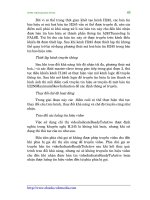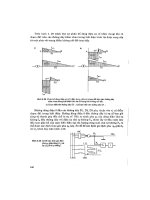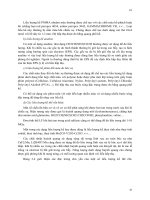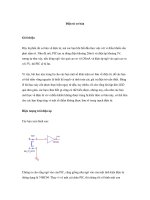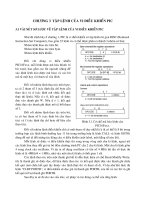NIGEL PIC Tutorial Hardware phần 5 potx
Bạn đang xem bản rút gọn của tài liệu. Xem và tải ngay bản đầy đủ của tài liệu tại đây (25.63 KB, 11 trang )
Message2 movf count, w ;put counter value in W
call Text2 ;get a character from the text
table
xorlw 0x00 ;is it a zero?
btfsc STATUS, Z
goto EndMessage
call LCD_Char
incf count, f
goto Message2
EndMessage
Stop goto Stop ;endless loop
;Subroutines and text tables
;LCD routines
;Initialise LCD
LCD_Init movlw 0x20 ;Set 4 bit mode
call LCD_Cmd
movlw 0x28 ;Set display shift
call LCD_Cmd
movlw 0x06 ;Set display character mode
call LCD_Cmd
movlw 0x0d ;Set display on/off and cursor
command
call LCD_Cmd
call LCD_Clr ;clear display
retlw 0x00
; command set routine
LCD_Cmd movwf templcd
swapf templcd, w ;send upper nibble
andlw 0x0f ;clear upper 4 bits of W
movwf LCD_PORT
bcf LCD_PORT, LCD_RS ;RS line to 0
call Pulse_e ;Pulse the E line high
movf templcd, w ;send lower nibble
andlw 0x0f ;clear upper 4 bits of W
movwf LCD_PORT
bcf LCD_PORT, LCD_RS ;RS line to 0
call Pulse_e ;Pulse the E line high
call Delay5
retlw 0x00
LCD_CharD addlw 0x30
LCD_Char movwf templcd
swapf templcd, w ;send upper nibble
andlw 0x0f ;clear upper 4 bits of W
movwf LCD_PORT
bsf LCD_PORT, LCD_RS ;RS line to 1
call Pulse_e ;Pulse the E line high
movf templcd, w ;send lower nibble
andlw 0x0f ;clear upper 4 bits of W
movwf LCD_PORT
bsf LCD_PORT, LCD_RS ;RS line to 1
call Pulse_e ;Pulse the E line high
call Delay5
retlw 0x00
LCD_Line1 movlw 0x80 ;move to 1st row, first column
call LCD_Cmd
retlw 0x00
LCD_Line2 movlw 0xc0 ;move to 2nd row, first column
call LCD_Cmd
retlw 0x00
LCD_Line1W addlw 0x80 ;move to 1st row, column W
call LCD_Cmd
retlw 0x00
LCD_Line2W addlw 0xc0 ;move to 2nd row, column W
call LCD_Cmd
retlw 0x00
LCD_CurOn movlw 0x0d ;Set display on/off and cursor
command
call LCD_Cmd
retlw 0x00
LCD_CurOff movlw 0x0c ;Set display on/off and cursor
command
call LCD_Cmd
retlw 0x00
LCD_Clr movlw 0x01 ;Clear display
call LCD_Cmd
retlw 0x00
LCD_HEX movwf tmp1
swapf tmp1, w
andlw 0x0f
call HEX_Table
call LCD_Char
movf tmp1, w
andlw 0x0f
call HEX_Table
call LCD_Char
retlw 0x00
Delay255 movlw 0xff ;delay 255 mS
goto d0
Delay100 movlw d'100' ;delay 100mS
goto d0
Delay50 movlw d'50' ;delay 50mS
goto d0
Delay20 movlw d'20' ;delay 20mS
goto d0
Delay5 movlw 0x05 ;delay 5.000 ms (4 MHz clock)
d0 movwf count1
d1 movlw 0xC7 ;delay 1mS
movwf counta
movlw 0x01
movwf countb
Delay_0
decfsz counta, f
goto $+2
decfsz countb, f
goto Delay_0
decfsz count1 ,f
goto d1
retlw 0x00
Pulse_e bsf LCD_PORT, LCD_E
nop
bcf LCD_PORT, LCD_E
retlw 0x00
;end of LCD routines
HEX_Table ADDWF PCL , f
RETLW 0x30
RETLW 0x31
RETLW 0x32
RETLW 0x33
RETLW 0x34
RETLW 0x35
RETLW 0x36
RETLW 0x37
RETLW 0x38
RETLW 0x39
RETLW 0x41
RETLW 0x42
RETLW 0x43
RETLW 0x44
RETLW 0x45
RETLW 0x46
Text addwf PCL, f
retlw 'H'
retlw 'e'
retlw 'l'
retlw 'l'
retlw 'o'
retlw 0x00
Text2 ADDWF PCL, f
RETLW 'R'
RETLW 'e'
RETLW 'a'
RETLW 'd'
RETLW 'y'
RETLW '.'
RETLW '.'
RETLW '.'
RETLW 0x00
end
As usual, first we need to set things up, after the normal variable declarations and port setting
we reach 'call LCD_Init', this sets up the LCD module. It first waits for 100mS to give the
module plenty of time to settle down, we then set it to 4 bit mode (0x20) and set the various
options how we want them - in this case, Display Shift is On (0x28), Character Entry Mode is
Increment (0x06), and Block Cursor On (0x0D). Once the LCD is setup, we can then start to
send data to it, this is read from a table, exactly the same as the LED sequencer in the earlier
tutorials - except this time we send the data to the LCD module (using LCD_Char) and use a
0x00 to mark the end of the table, thus removing the need to maintain a count of the characters
printed. Once the first line is displayed we then sent a command to move to the second line
(using call LCD_Line2), and then print the second line from another table. After that we enter an
endless loop to leave the display as it is.
This program introduces a new use of the 'goto' command, 'goto $+2' - '$' is an MPASM
arithmetic operator, and uses the current value of the program counter, so 'goto $+2' means jump
to the line after the next one - 'goto $+1' jumps to the next line, and may seem pretty useless (as
the program was going to be there next anyway), but it can be extremely useful. A program
branch instruction (like goto) uses two instruction cycles, whereas other instructions only take
one, so if you use a 'nop' in a program it takes 1uS to execute, and carries on from the next line -
however, if you use 'goto $+1' it still carries on from the next line, but now takes 2uS. You'll
notice more use of the 'goto $' construction in later tutorials, if you are checking an input pin and
waiting for it to change state you can use 'goto $-1' to jump back to the previous line, this saves
allocating a label to the line that tests the condition.
This is a table of the LCD subroutines provided in these programs, you can easily add more if
you wish - for instance to set a line cursor rather than a block one, if you find you are using a
particular feature a lot you may as well make a subroutine for it.
LCD Subroutines
LCD_Init Initialise LCD Module
LCD_Cmd Sent a command to the LCD
LCD_CharD
Add 0x30 to a byte and send to the LCD
(to display numbers as ASCII)
LCD_Char Send the character in W to the LCD
LCD_Line1 Go to start of line 1
LCD_Line2 Go to start of line 2
LCD_Line1W Go to line 1 column W
LCD_Line2W Go to line 2 column W
LCD_CurOn Turn block cursor on
LCD_CurOff Turn block cursor off
LCD_Clr Clear the display
LCD_HEX Display the value in W as Hexadecimal
Tutorial 3.2 - requires Main Board and LCD Board.
This program displays a text message on the top line and a running 16 bit counter on the
bottom line, with the values displayed in both decimal and hexadecimal , it consists mostly of
the previous subroutines for using the LCD module, plus an extra one for converting from 16 bit
hexadecimal to decimal.
;LCD 16 bit counter
;Nigel Goodwin 2002
LIST p=16F628 ;tell assembler what chip we are using
include "P16F628.inc" ;include the defaults for the chip
ERRORLEVEL 0, -302 ;suppress bank selection messages
__config 0x3D18 ;sets the configuration settings
(oscillator type etc.)
cblock 0x20 ;start of general purpose
registers
count ;used in looping routines
count1 ;used in delay routine
counta ;used in delay routine
countb ;used in delay routine
tmp1 ;temporary storage
tmp2
templcd ;temp store for 4 bit mode
templcd2
NumL ;Binary inputs for decimal
convert routine
NumH
TenK ;Decimal outputs from convert
routine
Thou
Hund
Tens
Ones
endc
LCD_PORT Equ PORTA
LCD_TRIS Equ TRISA
LCD_RS Equ 0x04 ;LCD handshake lines
LCD_RW Equ 0x06
LCD_E Equ 0x07
org 0x0000
movlw 0x07
movwf CMCON ;turn comparators off (make it
like a 16F84)
Initialise clrf count
clrf PORTA
clrf PORTB
clrf NumL
clrf NumH
SetPorts bsf STATUS, RP0 ;select bank 1
movlw 0x00 ;make all pins outputs
movwf LCD_TRIS
bcf STATUS, RP0 ;select bank 0
call LCD_Init ;setup LCD
clrf count ;set counter register to zero
Message movf count, w ;put counter value in W
call Text ;get a character from the text
table
xorlw 0x00 ;is it a zero?
btfsc STATUS, Z
goto NextMessage
call LCD_Char
incf count, f
goto Message
NextMessage call LCD_Line2 ;move to 2nd row, first column
call Convert ;convert to decimal
movf TenK, w ;display decimal characters
call LCD_CharD ;using LCD_CharD to convert to
ASCII
movf Thou, w
call LCD_CharD
movf Hund, w
call LCD_CharD
movf Tens, w
call LCD_CharD
movf Ones, w
call LCD_CharD
movlw ' ' ;display a 'space'
call LCD_Char
movf NumH, w ;and counter in hexadecimal
call LCD_HEX
movf NumL, w
call LCD_HEX
incfsz NumL, f
goto Next
incf NumH, f
Next call Delay255 ;wait so you can see the digits
change
goto NextMessage
;Subroutines and text tables
;LCD routines
;Initialise LCD
LCD_Init call Delay100 ;wait for LCD to settle
movlw 0x20 ;Set 4 bit mode
call LCD_Cmd
movlw 0x28 ;Set display shift
call LCD_Cmd
movlw 0x06 ;Set display character mode
call LCD_Cmd
movlw 0x0c ;Set display on/off and cursor
command
call LCD_Cmd ;Set cursor off
call LCD_Clr ;clear display
retlw 0x00
; command set routine
LCD_Cmd movwf templcd
swapf templcd, w ;send upper nibble
andlw 0x0f ;clear upper 4 bits of W
movwf LCD_PORT
bcf LCD_PORT, LCD_RS ;RS line to 1
call Pulse_e ;Pulse the E line high
movf templcd, w ;send lower nibble
andlw 0x0f ;clear upper 4 bits of W
movwf LCD_PORT
bcf LCD_PORT, LCD_RS ;RS line to 1
call Pulse_e ;Pulse the E line high
call Delay5
retlw 0x00
LCD_CharD addlw 0x30 ;add 0x30 to convert to ASCII
LCD_Char movwf templcd
swapf templcd, w ;send upper nibble
andlw 0x0f ;clear upper 4 bits of W
movwf LCD_PORT
bsf LCD_PORT, LCD_RS ;RS line to 1
call Pulse_e ;Pulse the E line high
movf templcd, w ;send lower nibble
andlw 0x0f ;clear upper 4 bits of W
movwf LCD_PORT
bsf LCD_PORT, LCD_RS ;RS line to 1
call Pulse_e ;Pulse the E line high
call Delay5
retlw 0x00
LCD_Line1 movlw 0x80 ;move to 1st row, first column
call LCD_Cmd
retlw 0x00
LCD_Line2 movlw 0xc0 ;move to 2nd row, first column
call LCD_Cmd
retlw 0x00
LCD_Line1W addlw 0x80 ;move to 1st row, column W
call LCD_Cmd
retlw 0x00
LCD_Line2W addlw 0xc0 ;move to 2nd row, column W
call LCD_Cmd
retlw 0x00
LCD_CurOn movlw 0x0d ;Set display on/off and cursor
command
call LCD_Cmd
retlw 0x00
LCD_CurOff movlw 0x0c ;Set display on/off and cursor
command
call LCD_Cmd
retlw 0x00
LCD_Clr movlw 0x01 ;Clear display
call LCD_Cmd
retlw 0x00
LCD_HEX movwf tmp1
swapf tmp1, w
andlw 0x0f
call HEX_Table
call LCD_Char
movf tmp1, w
andlw 0x0f
call HEX_Table
call LCD_Char
retlw 0x00
Delay255 movlw 0xff ;delay 255 mS
goto d0
Delay100 movlw d'100' ;delay 100mS
goto d0
Delay50 movlw d'50' ;delay 50mS
goto d0
Delay20 movlw d'20' ;delay 20mS
goto d0
Delay5 movlw 0x05 ;delay 5.000 ms (4 MHz clock)
d0 movwf count1
d1 movlw 0xC7 ;delay 1mS
movwf counta
movlw 0x01
movwf countb
Delay_0
decfsz counta, f
goto $+2
decfsz countb, f
goto Delay_0
decfsz count1 ,f
goto d1
retlw 0x00
Pulse_e bsf LCD_PORT, LCD_E
nop
bcf LCD_PORT, LCD_E
retlw 0x00
;end of LCD routines
HEX_Table ADDWF PCL , f
RETLW 0x30
RETLW 0x31
RETLW 0x32
RETLW 0x33
RETLW 0x34
RETLW 0x35
RETLW 0x36
RETLW 0x37
RETLW 0x38
RETLW 0x39
RETLW 0x41
RETLW 0x42
RETLW 0x43
RETLW 0x44
RETLW 0x45
RETLW 0x46
Text addwf PCL, f
retlw '1'
retlw '6'
retlw ' '
retlw 'B'
retlw 'i'
retlw 't'
retlw ' '
retlw 'C'
retlw 'o'
retlw 'u'
retlw 'n'
retlw 't'
retlw 'e'
retlw 'r'
retlw '.'
retlw 0x00
;This routine downloaded from
Convert: ; Takes number in NumH:NumL
; Returns decimal in
; TenK:Thou:Hund:Tens:Ones
swapf NumH, w
iorlw B'11110000'
movwf Thou
addwf Thou,f
addlw 0XE2
movwf Hund
addlw 0X32
movwf Ones
movf NumH,w
andlw 0X0F
addwf Hund,f
addwf Hund,f
addwf Ones,f
addlw 0XE9
movwf Tens
addwf Tens,f
addwf Tens,f
swapf NumL,w
andlw 0X0F
addwf Tens,f
addwf Ones,f
rlf Tens,f
rlf Ones,f
comf Ones,f
rlf Ones,f
movf NumL,w
andlw 0X0F
addwf Ones,f
rlf Thou,f
movlw 0X07
movwf TenK
; At this point, the original number is
; equal to
; TenK*10000+Thou*1000+Hund*100+Tens*10+Ones
; if those entities are regarded as two's
; complement binary. To be precise, all of
; them are negative except TenK. Now the number
; needs to be normalized, but this can all be
; done with simple byte arithmetic.
movlw 0X0A ; Ten
Lb1:
addwf Ones,f
decf Tens,f
btfss 3,0
goto Lb1
Lb2:
addwf Tens,f
decf Hund,f
btfss 3,0
goto Lb2
Lb3:
addwf Hund,f
decf Thou,f
btfss 3,0
goto Lb3
Lb4:
addwf Thou,f
decf TenK,f
btfss 3,0
goto Lb4
retlw 0x00
end
Tutorial 3.3 - requires Main Board and LCD Board.
This program displays a text message on the top line and a running 16 bit counter on the
bottom line, just as the last example, however, instead of using the Delay calls this version waits
until the LCD Busy flag is clear. The LCD module takes time to carry out commands, these
times vary, and the previous tutorials used a delay more than long enough to 'make sure' -
however, the modules have the capability of signalling when they are ready, this version uses
that facility and avoids any unnecessary delays. I've also used the LCD_Line2W routine to
position the numbers further to the right and demonstrate the use of the routine, another slight
change is that the tables have been moved to the beginning of program memory, this was done
because it's important that tables don't cross a 256 byte boundary, so putting them at the start
avoids this.
;LCD 16 bit counter - using LCD Busy line
;Nigel Goodwin 2002
LIST p=16F628 ;tell assembler what chip we are using
include "P16F628.inc" ;include the defaults for the chip
ERRORLEVEL 0, -302 ;suppress bank selection messages
__config 0x3D18 ;sets the configuration settings
(oscillator type etc.)
cblock 0x20 ;start of general purpose
registers
count ;used in looping routines
count1 ;used in delay routine
counta ;used in delay routine
countb ;used in delay routine
tmp1 ;temporary storage
tmp2
templcd ;temp store for 4 bit mode
templcd2
NumL ;Binary inputs for decimal
convert routine
NumH
TenK ;Decimal outputs from convert
routine
Thou
Hund
Tens
Ones
endc
LCD_PORT Equ PORTA
LCD_TRIS Equ TRISA
LCD_RS Equ 0x04 ;LCD handshake lines
LCD_RW Equ 0x06
LCD_E Equ 0x07
org 0x0000
goto Start
HEX_Table ADDWF PCL , f
RETLW 0x30
RETLW 0x31
RETLW 0x32
RETLW 0x33
RETLW 0x34
RETLW 0x35
RETLW 0x36
RETLW 0x37
RETLW 0x38
RETLW 0x39
RETLW 0x41
RETLW 0x42
RETLW 0x43
RETLW 0x44
RETLW 0x45
RETLW 0x46
Text addwf PCL, f
retlw '1'
retlw '6'
retlw ' '
retlw 'B'
retlw 'i'
retlw 't'
retlw ' '
retlw 'C'
retlw 'o'
retlw 'u'
